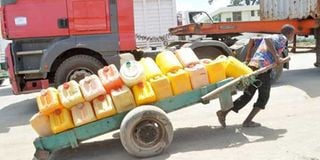Mombasa borehole water has faecal contamination: County govt

A water vendor pushes a hand cart in Jomvu along the Mombasa-Nairobi Highway on April 13, 2016. Parts of Mombasa County have continued to experience acute water shortages after the revocation of 2,500 vendors’ licences. PHOTO | KEVIN ODIT | NATION MEDIA GROUP
Anxiety has gripped Mombasa residents after the local government revealed that borehole water contains a high percentage of faecal matter.
As a result, the Governor Hassan Joho-led administration warned that the water is not safe for domestic use.
The county says the entire port city has 452 shallow wells, however, environmentalists put the number at more than 800.
For years, Mombasa has been grappling with acute water shortage, forcing many landlords to sink boreholes for both their tenants and for commercial purposes.
The administration says water demand for the county stands at 186,000 cubic metres a day against a supply of 42,000 cubic metres.
But with a large population relying on borehole water, Mombasa county is staring at a crisis due to the revelation that the water is not fit for human consumption.
Tap water consumed in the county is managed by the Mombasa Water and Sewerage Company (Mowasco), which obtains its supply mainly from Mzima Springs in Taita Taveta; Sabaki/Baricho in Kilifi; and Marere and Tiwi boreholes in Kwale County.
Available supply
“The available supply can only meet about 25 per cent of the demand and thus there is a need for concerted efforts to address the water deficit. The establishment of desalination plants that will address the shortfall has been prioritised within the county development plans,” the county government stated in its draft fiscal strategy paper 2021.
The paper further stated that a large population relies on the unsafe borehole water.
“There are 452 shallow wells spread across the entire county, three permanent springs, four water pans found in the remote areas of the county and a number of boreholes operated by private investors, NGOs and local CBOs. These sources are complemented by the pipe water system. The piping system is rehabilitated in phases by the Coast Water Works Development Authority, with the support of the Water and Sanitation Development Project (WSDP) by the World Bank, as it is a capital-intensive project,” added the paper.
A certified environmental inspector, Mr Benson Wemali termed the contaminated water a time bomb.
“This is very dangerous because Mombasa lacks a sewerage plant. Households lack sewerage connection. Most houses in the city have soak pit and septic tanks. Sadly, most boreholes are dug near the septic and soak pits for easier connectivity and flow of water from the boreholes,” said Mr Wemali.
Most of the septic tanks are not well constructed, hence the boreholes attract a lot of pollution from them.
“In that connection, the same borehole water is used for domestic use. Though most residents suffer from non-communicable diseases that they don’t know how they contracted, the contaminated water is dangerous,” he warned.
The faecal contamination problem is perennial, he said, adding that underground soil has been contaminated.
“Mombasa being an island, any house constructed must have a borehole. But I blame water agencies for failing in their mandate. The authorities that give licences for boreholes don’t inspect them,” he added.
Mr Wemali further blamed the department of environment in the county for lack of proper zoning to control boreholes. He said the county must know individuals operating the boreholes.
All boreholes in Mombasa have salty water due to proximity to the Indian Ocean.
“The county should monitor the boreholes, have standards on which type of house should have the wells and further ensure houses with many floors are connected to the water system. Some are used as storm water drainage and to dump toxins,” he warned.
Mr Wemali urged the county to ensure landlords install small treatment plants in their houses to clean up the water.





